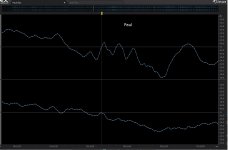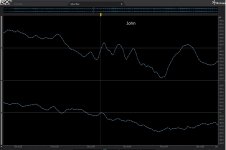Can you tell original file from three times DA-AD converted?
Inspired by PMA's listening tests, I've set up another one that might be interesting.
One file is the original and the other is a threefold(!) iteration of a playback and recording process with DAC+ADC connected with loopback cables (1.5m RCA's of the cheapest variety).
Dropbox - org-vs-3x(DA-AD).zip
Please vote and post your impressions:
- do you hear a difference?
- do you prefer one of the files?
- can you identify the orignal?
If you opt to do an ABX test, please post the logfile.
Details:
0) Device used was a RME Adi-2 Pro FS connected via USB, thus the record-while-playback processes were sample-synchronous.
1) Original file had to be reduced by 3dB because it caused some intersample overs, and was saved as newly dithered 24-bit data.
2) All playback/recording was at 44.1kHz/24bit, saved as 32bit floating-point data to avoid additional dithering.
3) The filters of the ADC and DAC were set to "sharp", which means linear-phase filters with sharp cutoff, a common choice.
4) The level of the analog link was set to +4dBu@0dBFS, for realistic real-life levels.
5) While levels were matched in the RME, the threefold iteration still caused a 0.22dB overall loss of level which has been corrected for after the last AD process and saved again as newly ditherered 24bit data.
6) Time offset has been precisly adjusted to remove any accidental clues in direct A/B from this offset during switching. This also allows to use crossfade option for the ABX which I like better than the short gap that is introduced by foobar's ABX which sort of irritates me.
Have fun!
Inspired by PMA's listening tests, I've set up another one that might be interesting.
One file is the original and the other is a threefold(!) iteration of a playback and recording process with DAC+ADC connected with loopback cables (1.5m RCA's of the cheapest variety).
Dropbox - org-vs-3x(DA-AD).zip
Please vote and post your impressions:
- do you hear a difference?
- do you prefer one of the files?
- can you identify the orignal?
If you opt to do an ABX test, please post the logfile.
Details:
0) Device used was a RME Adi-2 Pro FS connected via USB, thus the record-while-playback processes were sample-synchronous.
1) Original file had to be reduced by 3dB because it caused some intersample overs, and was saved as newly dithered 24-bit data.
2) All playback/recording was at 44.1kHz/24bit, saved as 32bit floating-point data to avoid additional dithering.
3) The filters of the ADC and DAC were set to "sharp", which means linear-phase filters with sharp cutoff, a common choice.
4) The level of the analog link was set to +4dBu@0dBFS, for realistic real-life levels.
5) While levels were matched in the RME, the threefold iteration still caused a 0.22dB overall loss of level which has been corrected for after the last AD process and saved again as newly ditherered 24bit data.
6) Time offset has been precisly adjusted to remove any accidental clues in direct A/B from this offset during switching. This also allows to use crossfade option for the ABX which I like better than the short gap that is introduced by foobar's ABX which sort of irritates me.
Have fun!
Last edited:
Hehe, hereby my result. Both files sound same, maybe there is a slightest difference?
Good file names, files are probably closer
Good file names, files are probably closer
Code:
foo_abx 2.0.2 report
foobar2000 v1.3.7
2018-11-25 18:02:19
File A: John.flac
SHA1: 342e8e2481768f09a9ef4e61289f46c44c7ec7dd
File B: Paul.flac
SHA1: 187cfd12d0ca41c93281010f94cffc61986c4162
Output:
WASAPI (event) : OUT (DUO-CAPTURE EX), 24-bit
Crossfading: NO
18:02:19 : Test started.
18:03:52 : 01/01
18:04:03 : 02/02
18:04:18 : 02/03
18:04:32 : 03/04
18:04:50 : 03/05
18:05:00 : 03/06
18:05:08 : 03/07
18:05:17 : 03/08
18:05:25 : 04/09
18:05:33 : 04/10
18:05:39 : 05/11
18:05:55 : 05/12
18:06:01 : 06/13
18:06:07 : 07/14
18:06:24 : 07/15
18:06:38 : 08/16
18:06:38 : Test finished.
----------
Total: 8/16
Probability that you were guessing: 59.8%
-- signature --
a27bbea2c33088ee4b05c00bbedb605e06017ca6Synchronous sampling can guarantee even phase information though I don't think a human can detect phase distortion. Asynchronous sampling may have the same result. The attached is visual data. White dots are the sampling points.
Attachments
Synchronous sampling can guarantee even phase information though I don't think a human can detect phase distortion. Asynchronous sampling may have the same result. The attached is visual data. White dots are the sampling points.
Yes I know that synchronous D/A A/D sampling guarantees right timing. However, the inserted D/A A/D compared to the original rip inevitably introduces slight analog phase changes and also top-end sharp digital filter slight changes. That was my point.
I have my own CoolEdit Pro analysis, but did not want to show before the poll expires, as this is a listening test.
Months ago, with foobar2000 + ABX I could not differentiate between different op-amps test, however it was easy with JRMC.
I only use foobar2000 to make CD rips and to resampler bad recordings (SoX and SSRC). And to play ISO (better sound than JRMC).
How to make the best FLAC. Convert, recoder and CD rip.
I only use foobar2000 to make CD rips and to resampler bad recordings (SoX and SSRC). And to play ISO (better sound than JRMC).
How to make the best FLAC. Convert, recoder and CD rip.
Last edited:
Gentlemen, thanks for your input. I'll disclose when the poll is over (next monday).
@PMA, there was no processing of any kind other than level alignments and corrected offset. The ADC and DAC digital filters were set to linear phase so no phase skewing from that but of course the analog filters (SCF in the DAC chip, analog DAC post filter, analog input and ADC pre filter) will all add up. Even when effectively the amplitude doesn't change within the audio range the phase introduced from all the analog filtering will cause sub-sample shifts. This is what we see in @xx3stksm's plots. I could have corrected for that but that would have required an additional upsampling-->offset correction-->downsamplig process.
It's important to realize (you certainly do) than one and the same signal can be represented by an infinite number of different sample sequences differing in actual sample values from sub-sample time shifts. Because of the threefold application of anti-aliasing (ADC) plus anti-imaging (DAC) filters there is still a lot of amplitde drop near Nyquist frequency, no way around that.
@PMA, there was no processing of any kind other than level alignments and corrected offset. The ADC and DAC digital filters were set to linear phase so no phase skewing from that but of course the analog filters (SCF in the DAC chip, analog DAC post filter, analog input and ADC pre filter) will all add up. Even when effectively the amplitude doesn't change within the audio range the phase introduced from all the analog filtering will cause sub-sample shifts. This is what we see in @xx3stksm's plots. I could have corrected for that but that would have required an additional upsampling-->offset correction-->downsamplig process.
It's important to realize (you certainly do) than one and the same signal can be represented by an infinite number of different sample sequences differing in actual sample values from sub-sample time shifts. Because of the threefold application of anti-aliasing (ADC) plus anti-imaging (DAC) filters there is still a lot of amplitde drop near Nyquist frequency, no way around that.
Last edited:
I don't have separate ADC and DAC devices of sufficient quality. Asynchronous clocks can't be used for direct A/B switching because they'll drift apart. Maybe OK for a few seconds or so. Or did you mean synchonized clocks in different devices via Word Clock inputs which would keep them in sync overall long term yet allow for individual jitter etc?
Yes, without the ABX, everyone is convinced he hears the difference even if the files are identical.
Not everyone.
Asynchronous clocks can't be used for direct A/B switching because they'll drift apart.
Not that much. Once I made a test of a digital wav file provided by a music company vs. vinyl rip of the same music, recorded from Technics direct drive crystal clocked turntable. Interestingly enough, masters for wav and vinyl were the same and the turntable changed timing very little. People were doing off line ABX (like here) and almost no one was able to get a positive result.
Exaggeration by me, of course. However close to what often happens - once I included 2 same files in a test of 4 files and people were reporting sound differences - in a sighted test, of course.
Reporting differences when listening to the identical stimulas twice in a A/B paired comparison (blind of course) is a common phenomenon. It gives up to 80% false answers (means reporting differences although none were obvious there).
Don´t want to hijack KSTR´s thread but would be interested to know what you think about that.
Don´t want to hijack KSTR´s thread but would be interested to know what you think about that.
Do you mean KSTR's test or my opinion on reporting sound differences of 2 identical files?
- Status
- This old topic is closed. If you want to reopen this topic, contact a moderator using the "Report Post" button.
- Home
- General Interest
- Everything Else
- Can you tell original file from three times DA-AD converted?

